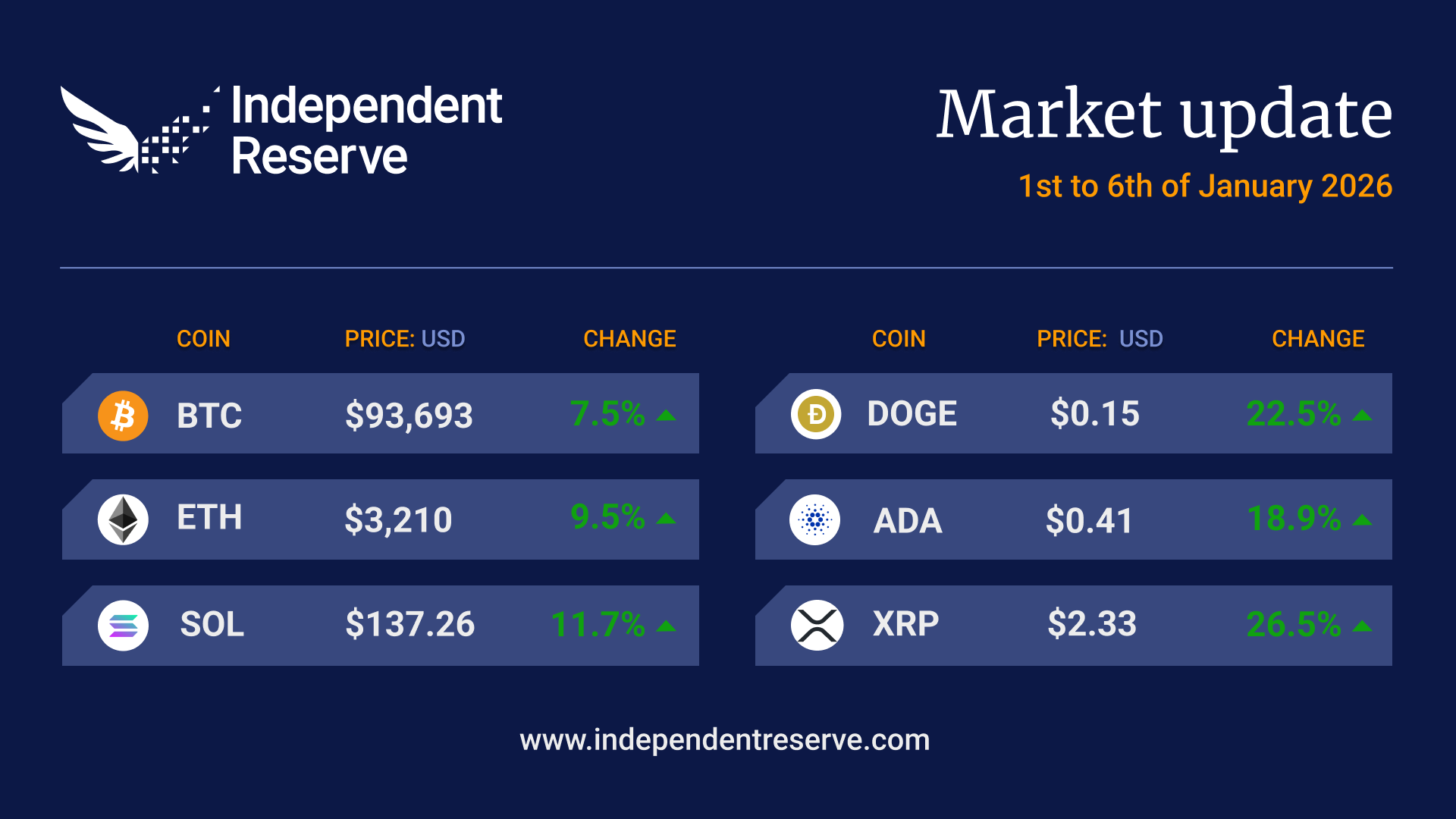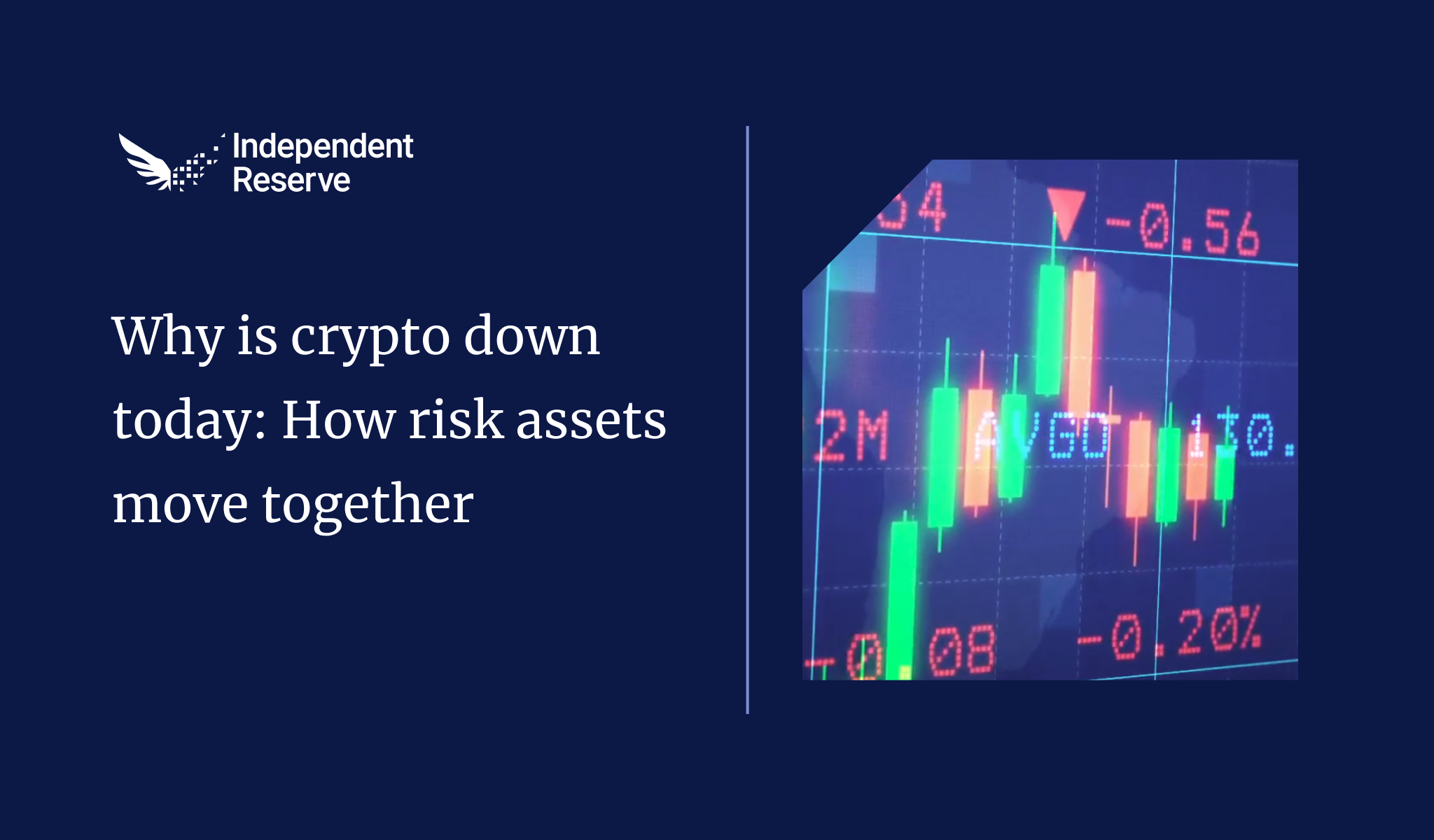In Markets
Visions of a crypto-funded retirement got pushed back a little this week after the prospect of interest rate cuts in the US this year began to dim, and markets sold off due to tension in the Middle East. That was before Sunday morning’s 8.4% BTC plunge when news broke that Iran had launched a slow-motion attack on Israel. Despite being the largest deleveraging event since mid-2023, Glassnode analyst Checkmate says it “looks a lot more like your garden variety correction” than the start of a new bear market. With the immediate threat of escalation diminishing, and crypto ETFs approved in Hong Kong, markets began to recover. Bitcoin is currently 12% down on a week ago and trading around A$98,750 (US$63,193), while Ethereum lost 17% to trade around A$4,804 (US$3081). Solana lost 24%, XRP fell 25%, Dogecoin (-21%), Cardano (-25%) and Shiba Inu (-24%). The Crypto Fear and Greed Index is at 74, or Greed.

From the IR OTC Desk
Last week’s update highlighted that “Rising bond yields and persistent inflation should be influencing the price of risk assets. The practical outcome, however, is that many risk assets continue to trade somewhat independently of the macroeconomic story.” This narrative has now changed. It is the macroeconomic landscape, as well as the geopolitical landscape, that are impacting the pricing of risk assets, including cryptocurrencies.
The catalyst for the change was last week’s US inflation report (March), which highlighted headline inflation of 3.5% YoY (March) versus 3.2% YoY (February). While there are many ways to measure inflation, one of the most discussed measures is the basket categorised by Federal Open Market Committee (FOMC) Chair Jerome Powell as the ‘Super Core’ measure. This grouping includes services inflation, excluding food, energy, and housing.
Of concern to FOMC officials, the Super Core reading printed at 4.8% YoY (March) and at nearly 8% on a 3-month annualised basis. While it is generally assumed that strong economic data is preferable for economic prosperity, macroeconomic markets are now concerned that strong economic data will erode the FOMC requirement to deliver interest rate cuts (relief) in the calendar year 2024. At the end of 2023, the short-term interest rate futures market forecast near seven, 25bp interest rate cuts for calendar year 2024! The FOMC have most recently forecast three, 25bps cuts for calendar year 2024. The futures market now has just over one built into the forward yield curve…
The result of higher US bond yields (the US 10-year treasury yield is now at 4.6%!), has been a higher USD index and a fall in the commodity currencies. AUDUSD is down nearly 3% over the calendar week, from an open of USD 0.6630 to now trade at USD 0.6440. Cryptocurrencies have also experienced significant price volatility, with those cryptocurrencies furthest out on the risk curve generally falling the most.
To complicate matters further, there remains ongoing geopolitical tension in the Middle East. And while this update is not long enough to outline the current landscape in extensive detail, escalating conflict between Israel and Iran must be monitored with particular caution.
This week’s economic calendar includes the Australian employment series for March, Thursday at 11:30 am AEST; the New Zealand inflation report (Q1), Wednesday at 08:45 am AEST.
On the OTC desk, de-risking has caused a flight to stablecoins. For now, this is detracted from the imminent BTC halving event – which is expected roughly four days from now. At some future point, the market will (most likely) assess the significance of the halving event in its individuality. For now, flows on the desk have tended to be risk-reducing, with notable buyers of both USDC and USDT. Enquiries for longer tail assets have temporarily slowed, and larger trades in the majors appear more opportunistic than high conviction.
What becomes quite telling in this type of environment is the relationship between cryptocurrency assets. Pricing differentials tend to highlight relative differences in creditworthiness. Of particular interest, ETH/BTC is now below 0.05 and trading at 0.0486. Flight to quality remains noticeable even in the majors.
For any further information, please feel free to reach out.
In Headlines
Bitcoin halving is this week
The mythical Bitcoin halving is almost upon us. Once every four years, the Bitcoin block reward for miners is cut in half, reducing the increase in Bitcoin’s supply and historically putting a rocket under the price. It hasn’t got a lot of mainstream coverage so far, and what little there is, can often be wrong, like the major Swiss newspaper that reported the “number of new Bitcoins will double.” The actual moment itself — sometime around lunch on Saturday AEST — is a bit like New Year’s Eve: people get very excited, but midnight comes, and nothing immediately changes. But after a few months, you get a much better sense of where the new year, or the new cycle, is going. Everybody seems to think it’s going up.
Bitcoin ETF outflows
Outflows from the Grayscale Bitcoin Trust last week saw a net outflow of US$82.5 million (A$128M) from the combined spot Bitcoin ETFs in the US last week. On the upside, a net US$12.53B (A$19.45B) has flowed in during their lifespans. Meanwhile, VanEck’s CEO Jan van Eck told CNBC this week that he believes the firm’s spot Ether ETF “will probably be rejected” in May.
Hong Kong Bitcoin and Ether ETFs approved
Hong Kong regulators have approved the launch of spot Bitcoin and spot Ether ETFs. Funds from ChinaAMC, Harvest Global and Bosera International have been given the nod by the Securities and Futures Commission. While the news is bullish, massive inflow predictions of up to US$25B (A$38.8B) seem unlikely. The Hong Kong ETF market is relatively small, and the US Bitcoin ETFs already hold more assets than all of the ETFs there combined. Bloomberg ETF analyst Eric Balchunas predicts the new ETFs will be “lucky to get US$500M (A$776M)” inflows between them, pointing out the fees are high, and the issuers approved are hardly “big fish.”
Solana congestion fix in the pipes
Solana developers have released an updated version of the validator client software intended to address congestion that saw up to 75% of transactions failing recently. Anza, a spinoff of Solana Labs, is asking validators to try it out on testnet.
Ethereum to upgrade to smart accounts
Ethereum’s core devs announced this week that Ethereum Improvement Proposal 3074, which brings smart contract-like functionality to wallets, will be included in the Pectra upgrade. While account abstraction was enabled last year, it required users to migrate to new wallets, whereas the new EIP will upgrade the functionality of existing wallets and enable users to access social recovery for lost private keys, approve batch transactions, and allow DApps to pay the gas fees for users. There are concerns by some that the upgrade might allow attackers to drain an entire wallet, however, Metamask’s Dan Finlay says that risk is an easy one for wallet designers to avoid.
Uniswap receives Wells Notice
The SEC has issued a Wells notice to DeFi protocol Uniswap, indicating it plans to recommend enforcement action. The SEC has been investigating Uniswap Labs since 2021. The charges aren’t clear but will likely be around operating as an unlicensed broker-dealer, operating an unregistered exchange, and selling unregistered securities. It’ll be an interesting case, as Uniswap Labs argues it’s only responsible for building the front-end portal to the smart contracts, which exist outside of their control and would still be operational even if Uniswap Labs ceased to exist.
Coinbase seeks appeal
Meanwhile, Coinbase is seeking an interlocutory appeal in the SEC’s lawsuit against it. The exchange believes that different opinions from different judges mean that the way the Howey test for securities is applied to crypto is a “controlling question of law” and wants to get it sorted out. Such appeals are difficult to win, however. In other legal news, prosecutors have accused Mango Markets manipulator Avraham “Avi” Eisenberg, who made off with US$110M (A$170M), of orchestrating a scheme similar in nature to a fake diamond ring scam.
Crypto schemes collapse
Two Aussie crypto outfits have collapsed into liquidation while owing investors A$160M. ASIC has launched civil proceedings against three crypto mining firms trading under the NGS banner and their directors, who allegedly targeted SMSF investors. Separately, DCA Capital, Digital Commodity Assets and the Digital Commodity Assets Fund have also been pushed into liquidation with legal proceedings against director Ashod Balanian over concerns about the management of funds and a lack of the relevant licences.
Bits and pieces
Trust Wallet has warned iPhone users of a new zero-day vulnerability in the iMessage application that puts their crypto at risk. They recommend disabling iMessage until Apple releases a fix. Prosecutors have dropped mining billionaire Andrew Forrest’s criminal case against Meta over crypto scam ads featuring his likeness. Norway has passed datacentre legislation so it can “close the door” to uses like Bitcoin mining that is “linked with large greenhouse gas emissions.” Ethereum gas fees hit a new low for 2024 of 12.5 gwei on the weekend. The UK is working on legislation to bring a “whole host” of crypto activities within the law, addressing both stablecoins and staking.


